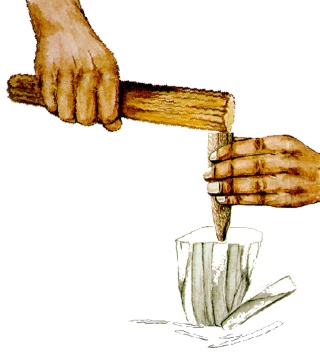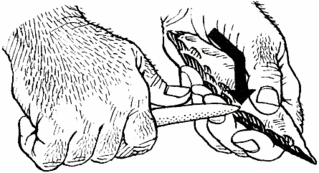The 4 Techniques of Knapping
2 posters
Page 1 of 1
 The 4 Techniques of Knapping
The 4 Techniques of Knapping
There a basically four kinds of knapping, each requires different equipment and utilise a different technique
Hammer & Anvil
Darn right dangerous, this is believed to be the first technique ever used and how the oldest tools were made. Most likely at first by accident then later intentionally.
Hammer and anvil is usually done with a large flint pebble. The pebble is held in one hand and hammered into a large hard boulder laying on the ground. Because flint is so hard, only certain rocks will do and need at least to be as hard as flint. Working out which part of the pebble should impact the boulder so it breaks and breaks in a desirable way is what makes it a skill and natural platforms should be exploited.
Primates today hammer things with stones, to break nuts for example. A credible theory for how this technique came about is early hominids placed the nuts on hard rocks and hit them with flint pebbles and they often broke. They noticed the broken flint pebbles made really useful cutting tools. As this excellent video demonstrates.
Indirect Percussion
One of the oldest forms of knapping and carries right on through to the very last knappers who made gun flints in Brandon in the 20th century. Some of the most complex knapping is achieved through indirect percussion and it can be used a complement to flaking to give an extra bit of precision to troubleshoot regular knapping or as a technique to create one of the most complex forms of knapping, a blade core.
Basically it is a simple hammer and chisel action where usually a soft percussion pressure flaking type tool is placed on the platform and hit with a hammer stone, giving that extra bit of control and accuracy but taking a lot of time to set up as the target needs to be braced in place.
[url= ]
]
Percussion Flaking
This technique quickly developed from Hammer & Anvil knapping, being both safer and more efficient, but requiring a specialist tool. Initially tools would have been hammer stones, large pebbles, but later the advantages of softer percussion, antler hammers, was discovered and it was used to create ever more advanced and artful knapping.
With percussion flaking the flint is held in one hand or rested upon your lap and flakes removed by hitting the stone with the percussion tool. Where the tool hits has to be prepared in advance, often many strikes in advance which is where the skill of knapping comes in.
Precussion is violent and is unsuitable for smaller pieces of Obsidian and weaker materials but works well on flint of all sizes.
Pressure flaking
This technique became particularly common after the megabeasts became extinct and the hunters were after smaller prey. It also allows a great deal of detail to be put into a piece and a high degree of aesthetic beauty. Knapped items in the past like today were not always for use and art objects were created. This became especially common in the Bronze Age where two things happened, knapping became easier because of the availability of copper tools and flint tools began to die out. So increasing fabulous artistic knapped objects appear as knappers upped their game to compete with bronze.
Pressure flaking is done by pressing a screwdriver like object or the point of an antler into the side of a previously thinned piece of flint and peeling off flakes. With hard materials like flint it can be very difficult and a lot of pressure needed, whereas with soft materials like obsidian it can be very simple.

Hammer & Anvil
Darn right dangerous, this is believed to be the first technique ever used and how the oldest tools were made. Most likely at first by accident then later intentionally.
Hammer and anvil is usually done with a large flint pebble. The pebble is held in one hand and hammered into a large hard boulder laying on the ground. Because flint is so hard, only certain rocks will do and need at least to be as hard as flint. Working out which part of the pebble should impact the boulder so it breaks and breaks in a desirable way is what makes it a skill and natural platforms should be exploited.
Primates today hammer things with stones, to break nuts for example. A credible theory for how this technique came about is early hominids placed the nuts on hard rocks and hit them with flint pebbles and they often broke. They noticed the broken flint pebbles made really useful cutting tools. As this excellent video demonstrates.
Indirect Percussion
One of the oldest forms of knapping and carries right on through to the very last knappers who made gun flints in Brandon in the 20th century. Some of the most complex knapping is achieved through indirect percussion and it can be used a complement to flaking to give an extra bit of precision to troubleshoot regular knapping or as a technique to create one of the most complex forms of knapping, a blade core.
Basically it is a simple hammer and chisel action where usually a soft percussion pressure flaking type tool is placed on the platform and hit with a hammer stone, giving that extra bit of control and accuracy but taking a lot of time to set up as the target needs to be braced in place.
[url=
 ]
]Percussion Flaking
This technique quickly developed from Hammer & Anvil knapping, being both safer and more efficient, but requiring a specialist tool. Initially tools would have been hammer stones, large pebbles, but later the advantages of softer percussion, antler hammers, was discovered and it was used to create ever more advanced and artful knapping.
With percussion flaking the flint is held in one hand or rested upon your lap and flakes removed by hitting the stone with the percussion tool. Where the tool hits has to be prepared in advance, often many strikes in advance which is where the skill of knapping comes in.
Precussion is violent and is unsuitable for smaller pieces of Obsidian and weaker materials but works well on flint of all sizes.
Pressure flaking
This technique became particularly common after the megabeasts became extinct and the hunters were after smaller prey. It also allows a great deal of detail to be put into a piece and a high degree of aesthetic beauty. Knapped items in the past like today were not always for use and art objects were created. This became especially common in the Bronze Age where two things happened, knapping became easier because of the availability of copper tools and flint tools began to die out. So increasing fabulous artistic knapped objects appear as knappers upped their game to compete with bronze.
Pressure flaking is done by pressing a screwdriver like object or the point of an antler into the side of a previously thinned piece of flint and peeling off flakes. With hard materials like flint it can be very difficult and a lot of pressure needed, whereas with soft materials like obsidian it can be very simple.

 Hammer and anvil
Hammer and anvil
Hammer and anvil (otherwise known as bipolar reduction).
"It is critical to understand that bipolar reduction provides a method of reducing even the smallest pebble where freehand percussion is useless. The ability to split pebbles in a controlled manner allowed hominins to subsist in environments where large isotropic material was absent. Yet, there are still many archaeologists who mistakenly believe bipolar reduction to be an inferior method resulting in random shattering that was surpassed by freehand direct percussion. This could not be further from the truth; bipolar reduction techniques are both flexible and predictable." Me, 2011....
For a comprehensive article explaining the technique google Bipolar Van Der Drift pdf, I can't post the link yet because I am a newbie!
"It is critical to understand that bipolar reduction provides a method of reducing even the smallest pebble where freehand percussion is useless. The ability to split pebbles in a controlled manner allowed hominins to subsist in environments where large isotropic material was absent. Yet, there are still many archaeologists who mistakenly believe bipolar reduction to be an inferior method resulting in random shattering that was surpassed by freehand direct percussion. This could not be further from the truth; bipolar reduction techniques are both flexible and predictable." Me, 2011....
For a comprehensive article explaining the technique google Bipolar Van Der Drift pdf, I can't post the link yet because I am a newbie!
 Re: The 4 Techniques of Knapping
Re: The 4 Techniques of Knapping
Thanks for that, got 3 great articles off the first three results on Google.
Welcome to the forum.
Welcome to the forum.
Page 1 of 1
Permissions in this forum:
You cannot reply to topics in this forum






